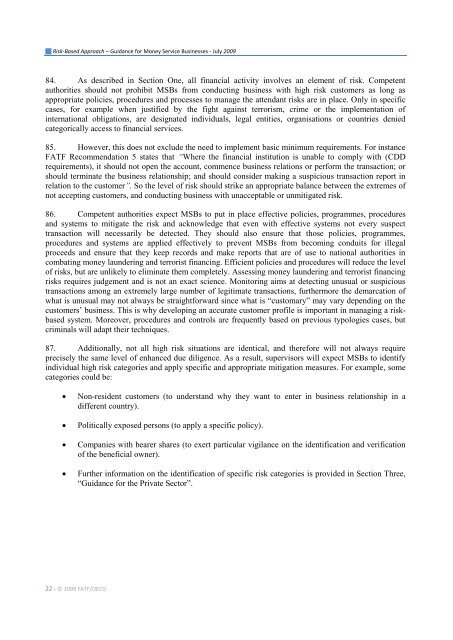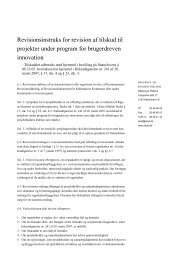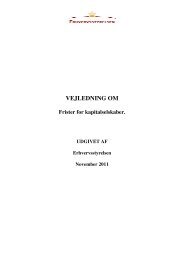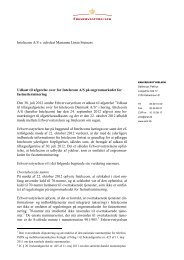<strong>Risk</strong>-<strong>Based</strong> <strong>Approach</strong> – <strong>Guidance</strong> <strong>for</strong> <strong>Money</strong> <strong>Service</strong> <strong>Businesses</strong> - July 200984. As described in Section One, all financial activity involves an element of risk. Competentauthorities should not prohibit MSBs from conducting business with high risk customers as long asappropriate policies, procedures and processes to manage the attendant risks are in place. Only in specificcases, <strong>for</strong> example when justified by the fight against terrorism, crime or the implementation ofinternational obligations, are designated individuals, legal entities, organisations or countries deniedcategorically access to financial services.85. However, this does not exclude the need to implement basic minimum requirements. For instanceFATF Recommendation 5 states that “Where the financial institution is unable to comply with (CDDrequirements), it should not open the account, commence business relations or per<strong>for</strong>m the transaction; orshould terminate the business relationship; and should consider making a suspicious transaction report inrelation to the customer”. So the level of risk should strike an appropriate balance between the extremes ofnot accepting customers, and conducting business with unacceptable or unmitigated risk.86. Competent authorities expect MSBs to put in place effective policies, programmes, proceduresand systems to mitigate the risk and acknowledge that even with effective systems not every suspecttransaction will necessarily be detected. They should also ensure that those policies, programmes,procedures and systems are applied effectively to prevent MSBs from becoming conduits <strong>for</strong> illegalproceeds and ensure that they keep records and make reports that are of use to national authorities incombating money laundering and terrorist financing. Efficient policies and procedures will reduce the levelof risks, but are unlikely to eliminate them completely. Assessing money laundering and terrorist financingrisks requires judgement and is not an exact science. Monitoring aims at detecting unusual or suspicioustransactions among an extremely large number of legitimate transactions, furthermore the demarcation ofwhat is unusual may not always be straight<strong>for</strong>ward since what is “customary” may vary depending on thecustomers‟ business. This is why developing an accurate customer profile is important in managing a riskbasedsystem. Moreover, procedures and controls are frequently based on previous typologies cases, butcriminals will adapt their techniques.87. Additionally, not all high risk situations are identical, and there<strong>for</strong>e will not always requireprecisely the same level of enhanced due diligence. As a result, supervisors will expect MSBs to identifyindividual high risk categories and apply specific and appropriate mitigation measures. For example, somecategories could be:Non-resident customers (to understand why they want to enter in business relationship in adifferent country).Politically exposed persons (to apply a specific policy).Companies with bearer shares (to exert particular vigilance on the identification and verificationof the beneficial owner).Further in<strong>for</strong>mation on the identification of specific risk categories is provided in Section Three,“<strong>Guidance</strong> <strong>for</strong> the Private Sector”.22 - © 2009 FATF/OECD
<strong>Risk</strong>-<strong>Based</strong> <strong>Approach</strong> – <strong>Guidance</strong> <strong>for</strong> <strong>Money</strong> <strong>Service</strong> <strong>Businesses</strong> - July 2009 Proportionate Supervisory Actions to support the <strong>Risk</strong>-<strong>Based</strong> <strong>Approach</strong>88. Supervisors should seek to identify weaknesses through an effective programme of both on-siteand off-site supervision 9 , and through analysis of internal and other available in<strong>for</strong>mation.89. In the course of their examinations, supervisors should review a MSB‟s AML/CFT riskassessments, as well as its policies, procedures and control systems to arrive at an overall assessment of therisk profile of the business and the adequacy of its mitigation measures. Where available, assessmentscarried out by or <strong>for</strong> the business may be a useful source of in<strong>for</strong>mation. The assessment should includesample transaction testing of customer transactions to validate the assessment. The supervisor‟s assessmentof management‟s ability and willingness to take necessary corrective action is also a critical determiningfactor. Supervisors should use proportionate actions to ensure proper and timely correction of deficiencies,taking into account that identified weaknesses can have wider consequences. Generally, systemicbreakdowns or inadequate controls will result in the most severe supervisory response.90. Nevertheless, it may happen that the lack of detection of an isolated high risk transaction, or oftransactions of an isolated high risk customer, will in itself be significant, <strong>for</strong> instance where the amountsare significant, or where the money laundering and terrorist financing typology is well known, or where ascheme has remained undetected <strong>for</strong> a long time. Such a case might indicate an accumulation of weak riskmanagement practices or regulatory breaches regarding the identification of high risks, transactionmonitoring, staff training and internal controls, and there<strong>for</strong>e, might alone justify supervisory action.91. Supervisors should be in a position to compare risk factors and procedures used by peer MSBs.This will, among other objectives, assist the supervisors in better understanding how MSBs are developingand implementing a risk-based approach, as well as in identifying potential deficiencies. Similarly,supervisors can and should use their knowledge of the risks associated with products, services, customersand geographic locations to help them evaluate the MSB‟s money laundering and terrorist financing riskassessment, with the understanding, however, that they may possess in<strong>for</strong>mation that has not been madeavailable to MSBs and, there<strong>for</strong>e, MSBs would not have been able to take such in<strong>for</strong>mation into accountwhen developing and implementing a risk-based approach. Supervisors (and other relevant stakeholders)are encouraged to use that knowledge to issue guidelines to assist MSBs in managing their risks. WhereMSBs are permitted to determine the extent of the CDD measures on a risk sensitive basis, this should beconsistent with guidelines issued by the competent authorities 10 . An assessment of the risk-based approachwill, <strong>for</strong> instance, help identify cases where businesses use excessively narrow risk categories that do notcapture all existing risks, or adopt criteria that lead to the identification of a large number of higher riskrelationships, but without providing <strong>for</strong> adequate additional due diligence measures.92. In the context of the risk-based approach, the primary focus <strong>for</strong> supervisors should be todetermine whether or not the MSB‟s AML/CFT compliance and risk management programme is adequateto: (a) meet the minimum regulatory requirements, and (b) appropriately and effectively mitigate the risks.The supervisory goal is not to prohibit high risk activity, but rather to be confident that MSBs haveadequately and effectively implemented appropriate risk mitigation strategies.93. Under FATF Recommendation 29, supervisors should impose adequate sanctions <strong>for</strong> failure tocomply with statutory and regulatory requirements to combat money laundering and terrorist financing,and effective AML/CFT supervision requires that the supervisor has available an appropriate range of910FATF Methodology <strong>for</strong> Assessing Compliance with the FATF 40 Recommendations and the FATF 9Special Recommendations, criteria 29.2.FATF Recommendations 5 & 25, Methodology <strong>for</strong> Assessing Compliance with the FATF 40Recommendations and the FATF 9 Special Recommendations, Essential Criteria 25.1 and 5.12.© 2009 FATF/OECD - 23
















